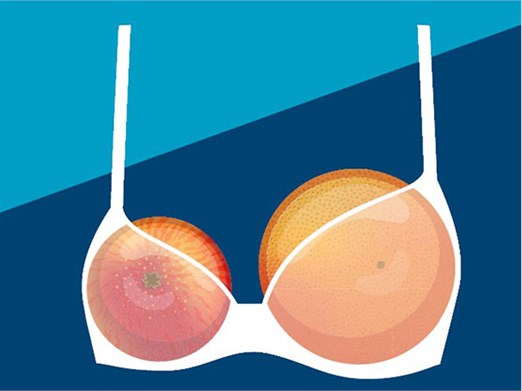Expectations of Reconstruction
 by Kathy Steligo
by Kathy Steligo
For many women, losing one or both breasts is the price of preventing or curing breast cancer. Fortunately, those who face mastectomy have several options to rebuild their breasts. Over the last decade, reconstruction has evolved into sophisticated surgical procedures that can be customized to a woman’s individual needs.
Reconstruction basics
Not so many years ago, the goal of breast reconstruction was to restore a woman’s profile when she was clothed. Today, the expectation is much higher. Highly-skilled surgeons can rebuild breasts that look natural whether a woman is clothed or not. And reconstructed breasts come in all sizes and shapes; they can be made smaller, larger or more symmetrical than their natural counterparts. In fact, women often consider their reconstructed breasts to be a cosmetic improvement compared to what Mother Nature gave them.
Immediate reconstruction is performed along with mastectomy. Usually, the nipple and areola are removed along with the breast tissue, but most of the breast skin is preserved to accommodate the new breast. Immediate reconstruction provides superior cosmetic results with less conspicuous incisions. When a woman doesn’t have immediate reconstruction—she may decide against it or her doctors may recommend she postpone reconstruction until she finishes chemotherapy or radiation treatments—most of her breast skin is removed during mastectomy. The good news is delayed reconstruction can be done any time after mastectomy—a woman who initially doesn’t want or can’t have reconstruction can pursue it even months or years after her mastectomy. The mastectomy scar remains on the new breast, but fades considerably with time.
Most reconstruction involves two or more operations over several months. The initial surgery forms the breast mounds, breasts without nipples. This first stage is the most complex and involves the most recovery. Depending on the procedure used, a shorter revision surgery refines the shape and size of the new breasts and adds nipples. Optional tattooing colors the nipple, simulates the areolas and completes the process.
Breast reconstruction offers a welcome antidote to mastectomy, but it’s still an imperfect process. Even the best surgeons and the newest techniques can’t completely eliminate breast scars, restore the ability to breastfeed or return full sensation to the breast and nipple.
How to recreate a breast
If you choose to have your breasts reconstructed, you have several options to consider: implants, your own tissue, or a combination of both.
Implants. Implants are the simplest and least invasive method of recreating breasts. After mastectomy, a temporary implant called an expander is placed under the chest muscle. Over several weeks, the expander is gradually inflated with saline. This stretches the skin and muscle sufficiently to hold an implant of the desired size. Then, in a shorter exchange surgery, the expanders are replaced with implants that fit your chest anatomy and desired size.
Two single-step methods of reconstruction may be options for small-breasted women. Some surgeons use an adjustable expander-implant; it is placed in the chest and gradually inflated. When fully expanded, it is sealed and remains in place, eliminating the need for exchange surgery. Another more recent technique eliminates the need for expansion by using patches of a synthesized skin product to hold a small implant in place.
Implants are either saline (a silicone shell filled with salt water) or silicone (liquid or cohesive gel). Breasts reconstructed with saline implants feel firmer than silicone, which is softer and has a texture more like natural breast tissue. The use of silicone implants is now approved for breast reconstruction in women of all ages, and breast augmentation in women ages 22 and older. Once controversial, virtually all studies failed to link silicone implants to serious diseases. Some concerns remain over how often the implants rupture and what happens when and if silicone migrates beyond the breast. The FDA suggests women with silicone implants have periodic MRIs to determine whether a "silent" rupture has occurred; unlike saline implants, rupture of a silicone implant may not be apparent. Implant reconstruction includes a day or two in the hospital and two to four weeks of recovery at home. Implants aren’t permanent. Eventually, they wear out and must be removed and/or replaced. Sometimes this occurs sooner if the implant leaks or is distorted by hard scar tissue that forms around it. Some implants must be replaced within a year of reconstruction; others may last for 15 years or longer. Reconstructive surgeons agree that radiation and implants aren’t the best combination, since radiation inhibits blood flow in the skin and damages elasticity.Implants are a good option for women who:
- prefer not to scar another area of their body
- don’t have enough excess fat to create a breast of the desired size
- don’t mind having to remove/replace the implants in the future
- prefer not to endure the lengthier surgery and recovery time necessary with flap reconstruction
Tissue Flaps. Flap reconstruction uses excess fat, skin and sometimes muscle to build the new breast. Because it’s made of your own warm, living tissue, a flap can be sculpted and customized to a greater degree than implants, and is the most natural type of reconstruction. Tissue flap reconstruction is more complex than implants and recovery can be more intense—this involves surgery at the chest and the donor site—but the overall reconstruction timeline is shorter. Unlike implants, flaps form full-size breasts during the initial operation. Additional surgery later refines the breast shape and creates the nipples.
The downside to this technique is that it removes a perfectly healthy muscle.
Breasts created from flaps need a robust blood supply to survive; how blood vessels are harvested defines the different flap procedures. Traditional attached flap surgeries use skin, fat and muscle from the back (latissimus dorsi flap) or the abdomen (attached TRAM flap). Skin and fat are cut away from the donor site, then tunneled under the skin to the chest and shaped into a breast. The new breast remains connected to its original blood supply (so it is “attached”). The downside to this technique is that it removes a perfectly healthy muscle to access the blood vessels within.
Free flaps are complete transplants. They use skin, fat, and only a small portion of muscle surrounding the blood vessels. This is technically more demanding than implant or attached flap surgeries. Free flaps are taken from the abdomen (free TRAM) or the buttocks (free gluteal flap).
Perforator flaps are the gold standard of breast reconstruction. Cosmetically, a perforator flap is similar to a free flap, but instead of removing the muscle, a specially-trained surgeon works through a surgical microscope to extract the tiny blood vessels feeding the flap. Fewer physicians are qualified to do this exacting surgery. Perforator flaps are taken from the abdomen (DIEP flap) or the buttock (GAP flap).
Flap reconstruction involves a three-or-four day hospital stay and four to six weeks of recovery at home. It’s a good option for women who:
- have sufficient donor tissue available
- don’t want to endure the expansion process
- prefer the most natural reconstruction possible
- have had previous radiation to the chest
- want to take advantage of the tummy tuck that results from an abdominal flap
Choosing a surgeon
Your plastic surgeon’s skill and experience greatly influences whether you’re satisfied with your reconstruction. So it’s well worth your time to shop around for a board-certified surgeon who has a good reputation and lots of satisfied patients. Look at photos of his work. Speak with other women who had the same type of reconstruction you’re considering. Your surgeon should inspire confidence and paint a clear picture of what you can expect before, during and after surgery.
Often surgeons discuss or recommend only the techniques they perform. If you want to know about a particular flap reconstruction, it makes sense to go directly to the source: consult with surgeons who are expert with that procedure, rather than someone who is not. Always get a second or third opinion; you may end up choosing the first surgeon you speak with, but it’s good to consider other professional opinions.
Bring a list of questions to your consultation visit, including:
How many reconstructive surgeries of this type have you performed?
- What risks are involved?
- How many scars will I have and where will they be?
- How long will the surgery, hospital stay and recovery be?
- What will recovery be like?
- When can I return to work?
- How many surgeries and office visits will be required over what period of time?
- What problems may occur and what will be done about them?
- What is the best result I can expect?
- What if I’m not satisfied with the results?
Paying for reconstruction
The Women’s Health and Cancer Rights Act of 1999 requires health insurance companies who pay for mastectomy to also pay for breast reconstruction and surgery to the other breast to achieve a symmetrical appearance. Insurance carriers must also pay for treatment for any complication from mastectomy or reconstruction. Many states have additional laws regarding mastectomy and reconstruction.







